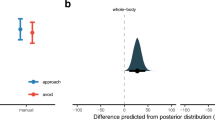Abstract
This study investigated the effects of habitual social approach and avoidance motivation on the classification of facial expressions of different visual clarity. Participants (N = 78) categorized partially masked emotional faces expressing either anger or happiness as positive or negative. Participants generally tended to interpret the facial expressions in a positive way. This positivity effect was reduced when persons were highly avoidance motivated. Social avoidance motivation predicted fewer positive and more negative interpretations in the least visible condition that provided extremely little information on the facial expression. Thus, people high in social avoidance motivation are likely to have anticipated angry faces as the facial stimuli offered only minimal information. The results for social approach motivation did not reach statistical significance. To conclude, it seems that persons who are most afraid of having negative social interactions (i.e., those high in social avoidance motivation), anticipate and interpret social information in the most negative way, which could lead to the reinforcement of the avoidance motivation.


Similar content being viewed by others
Notes
In a pilot study, we tested how many of the “grain” commands are needed to significantly reduced the visibility. Based on the results of the pilot study, we used 10 “grain” commands for the creation of very high visibility, additional 15 “grain” commands for the creation of high visibility, and for each other condition (medium visibility, low visibility, and very low visibility) additional six “grain” commands in the current study.
As the procedure was new, we included a relatively high number of different visibility conditions and a relatively high number of different facial stimuli. This procedure aimed at enhancing the reliability of the measurement.
The reaction times did not systematically differ between the conditions and as a function of social motivation.
We found no significant effects of gender of the participants or gender or age of the models on the results.
We also explored if the correlations differed in the other visibility conditions. This was the case for false classifications of angry faces in the medium visibility condition (approach motivation: r = .23, p = .048; avoidance motivation: r = −.13, p = .256; z = 2.22, p = .026) and for false classifications of angry faces in the very high visibility condition (approach motivation: r = .13, p = .246; avoidance motivation: r = −.24, p = .037; z = 2.30, p = .021). None of the other correlations were significantly different from each other (all ps > .071).
References
Ainsworth, M. D. S., Bell, S. M., & Stayton, D. J. (1974). Infant–mother attachment and social development: Socialisation as a product of reciprocal responsiveness to signals. In M. J. M. Richards (Ed.), The integration of a child into a social world (pp. 99–135). London: Cambridge University Press.
Baumeister, R. F., & Leary, M. R. (1995). The need to belong: Desire for interpersonal attachments as a fundamental human motivation. Psychological Bulletin, 117, 497–529. doi:10.1037//0033-2909.117.3.497.
Blanchard-Fields, F., Stein, R., & Watson, T. L. (2004). Age differences in emotion–regulation strategies in handling everyday problems. Journals of Gerontology. Series B, Psychological Sciences and Social Sciences, 59, 261–269. doi:10.1093/geronb/59.6.P261.
Cacioppo, J. T., Gardner, W. L., & Berntson, G. G. (1999). The affect system has parallel and integrative processing components: Form follows function. Journal of Personality and Social Psychology, 76, 839–855. doi:10.1037//0022-3514.76.5.839.
Cacioppo, J. T., & Hawkley, L. C. (2005). People thinking about people: The vicious cycle of being a social outcast in one’s own mind. In K. D. Williams, J. P. Forgas, & W. von Hippel (Eds.), The social outcast: Ostracism, social exclusion, rejection, and bullying (pp. 91–108). New York: Psychology Press.
Chartrand, T. L., & Bargh, J. A. (1999). The chameleon effect: The perception–behavior link and social interaction. Journal of Personality and Social Psychology, 76, 893–910. doi:10.1037//0022-3514.76.6.893.
Downey, G., & Feldman, S. I. (1996). Implications of rejection sensitivity for intimate relationships. Journal of Personality and Social Psychology, 70, 1327–1343. doi:10.1037//0022-3514.70.6.1327.
Ebner, N. C., Riediger, M., & Lindenberger, U. (2010). FACES–a database of facial expressions in young, middle-aged, and older women and men: Development and validation. Behavior Research Methods, 42, 351–362. doi:10.3758/BRM.42.1.351.
Ekman, P. (1992). An argument for basic emotions. Cognition and Emotion, 6, 169–200. doi:10.1080/02699939208411068.
Elliot, A. J., & Covington, M. V. (2001). Approach and avoidance motivation. Educational Psychology Review, 13, 73–92.
Gable, S. L. (2006). Approach and avoidance social motives and goals. Journal of Personality, 74, 175–222. doi:10.1111/j.1467-6494.2005.00373.x.
Gable, S. L., & Berkman, E. T. (2008). Making connections and avoiding loneliness: Approach and avoidance social motives and goals. In A. J. Elliot (Ed.), Handbook of approach and avoidance motivation (pp. 204–216). New York: Psychology Press.
Gable, S. L., Reis, H. T., & Elliot, A. J. (2003). Evidence for bivariate systems: An empirical test of appetition and aversion across domains. Journal of Research in Personality, 37, 349–372. doi:10.1016/S0092-6566(02)00580-9.
Gomez, A., & Gomez, R. (2002). Personality traits of the behavioural approach and inhibition systems: Associations with processing of emotional stimuli. Personality and Individual Differences, 32, 1299–1316. doi:10.1016/S0191-8869(01)00119-2.
Harlow, H. F. (1958). The nature of love. American Psychologist, 13, 673–685.
Jarvis, B. G. (2004). Direct RT (Version 2004.3.24). New York, NY: Empirisoft Corporation.
Lee, I. A., & Preacher, K. J. (2013). Calculation for the test of the difference between two dependent correlations with one variable in common [Computer software]. Retrieved from http://quantpsy.org.
McClelland, D. C. (1985). Human motivation. New York: Scott, Foresman.
Mehrabian, A. (1994). Evidence bearing on the affiliative tendency (MAFF) and sensitivity to rejection (MSR) scales. Current Psychology, 13, 97–116. doi:10.1007/BF02686794.
Nikitin, J., Burgermeister, L. C., & Freund, A. M. (2012). The role of age and social motivation in developmental transitions in young and old adulthood. Frontiers in Developmental Psychology, 6, 366. doi:10.3389/fpsyg.2012.00366.
Nikitin, J., & Freund, A. M. (2011). Age and motivation predict gaze behavior for facial expressions. Psychology and Aging, 26, 695–700. doi:10.1037/a0023281.
Sokolowski, K., Schmalt, H. -D., Langens, T. A., & Pucca, R. M. (2000). Assessing achievement, affiliation, and power motives all at once: The multi-motive grid (MMG). Journal of Personality Assessment, 74, 126–145. doi:10.1207/S15327752JPA740109.
Stanislaw, H., & Todorov, N. (1999). Calculation of signal detection theory measures. Behavior Research Methods, Instruments, and Computers, 95382, 137–149. doi:10.3758/BF03207704.
Strachman, A., & Gable, S. L. (2006). What you want (and do not want) affects what you see (and do not see): Avoidance social goals and social events. Personality and Social Psychology Bulletin, 32, 1446–1458. doi:10.1177/0146167206291007.
Taylor, S. E., & Brown, J. D. (1988). Illusion and well-being: A social psychological perspective on mental health. Psychological Bulletin, 103, 193–210. doi:10.1037//0033-2909.103.2.193.
Acknowledgments
This research was supported by a Grant of the funding by Suzanne and Hans Biäsch Foundation for Applied Psychology, Switzerland (principle investigator: Jana Nikitin). We thank the Life-Management team for helpful discussions of the work reported in this paper.
Author information
Authors and Affiliations
Corresponding author
Rights and permissions
About this article
Cite this article
Nikitin, J., Freund, A.M. What you want to avoid is what you see: Social avoidance motivation affects the interpretation of emotional faces. Motiv Emot 39, 384–391 (2015). https://doi.org/10.1007/s11031-014-9459-5
Published:
Issue Date:
DOI: https://doi.org/10.1007/s11031-014-9459-5




